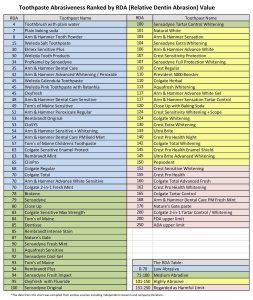
There has been a lot of buzz going around about the additives in toothpaste and what they do to our teeth. Many people look for whitening or tartar control toothpastes to brighten their smile, while others are on the hunt for a paste that allows them to eat ice cream without cringing. How do we decide what toothpastes are good for our teeth and which ones to avoid?
 Our office now hands out a list of toothpastes widely used on the market and where they land in abrasiveness. It is a good way to choose a toothpaste option that is studied and determined safe for your teeth. Abrasives are added into toothpastes to help achieve a “whitening” look. These abrasives basically scratch the tooth surface, including recession areas, in hopes of removing surface stain. In order to whiten teeth, a bleach of some sort needs to penetrate through enamel into the second layer of the tooth, called dentin. There is not a toothpaste on the market that can make this happen (nor is there a rinse).
Our office now hands out a list of toothpastes widely used on the market and where they land in abrasiveness. It is a good way to choose a toothpaste option that is studied and determined safe for your teeth. Abrasives are added into toothpastes to help achieve a “whitening” look. These abrasives basically scratch the tooth surface, including recession areas, in hopes of removing surface stain. In order to whiten teeth, a bleach of some sort needs to penetrate through enamel into the second layer of the tooth, called dentin. There is not a toothpaste on the market that can make this happen (nor is there a rinse).
Over the years, we’ve told patients to avoid brushing with a medium or hard bristled brush and to avoid scrubbing. We have still been finding increased areas of recession (receding gums, exposing the root of the tooth) as well as notched areas at the gumline. These areas are called abfractions. Dental professionals further studied what could be causing this increase and what can be done. These studies are finding that the amount of abrasives in toothpaste is actually leading to recession and abfractions. Choosing a toothpaste that is low in relative dentin abrasives can reduce or eliminate the risk of further damage.
If you buy toothpaste that doesn’t happen to fall on the RDA list and you’d like to know if it is safe, consider trying the “tinfoil test.” A patient of ours recommended this and we tried it! It actually worked quite well! Dab toothpaste on the shiny side of tinfoil and rub it in for two minutes. Rinse the area off and if there is any dullness, it is abrasive.
I often recommend to patients to take a picture of the RDA list with their phone so they have it with them the next time they’re out shopping for toothpaste. Happy brushing 🙂